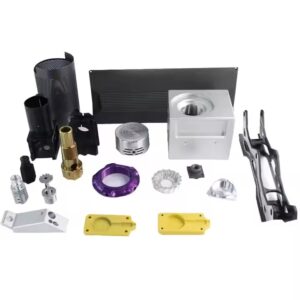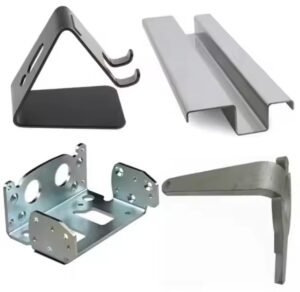Today I will share with you the commonly used materials for hardware stamping parts:
I. Cold-rolled steel sheet:
- Definition: Cold rolling is the process of rolling hot-rolled coils at room temperature below the recrystallization temperature. Cold-rolled steel plate, or cold plate, is produced through the cold rolling process. The thickness of cold-rolled plates is generally between 0.1 and 8.0mm. Most factories produce cold-rolled steel plates with a thickness below 4.5mm. The thickness and width of cold-rolled plates are determined by the equipment capabilities and market demands of each factory.
- Classification: SPCC: S stands for Steel, P for Plate, C for Cold, C for Commercial, according to the Japanese JIS standard. SPCD: Stands for cold-rolled carbon steel sheet and strip for stamping, equivalent to Chinese 08AL (13237) high-quality carbon structural steel. SPCE: Stands for cold-rolled carbon steel sheet and strip for deep drawing, equivalent to Chinese 08AL (5213) deep drawing steel.

II. Galvanized steel plate:
- Definition: Galvanized steel plate is a welded steel plate with a hot-dip galvanized or electroplated zinc layer on the surface.
- Classification: Electroplated galvanized steel plate (SECC): Uniform gray, mainly imported, fingerprint-resistant, excellent corrosion resistance, and retains the processing characteristics of cold-rolled plates. Used in household appliances, computer case shells, and some door panels and panels. Hot-dip galvanized steel plate (SGCC): Immersed, bright white, small zinc flower (difficult to see), large zinc flower can be clearly seen in hexagonal blocks. Only two factories in Taiwan, China Steel, and Shengyu Steel Corporation, can produce it domestically, relying mainly on imports.
- Main characteristics: Corrosion resistance, paintability, formability, and spot weldability. Widely used for components requiring a good appearance in small household appliances, but SECC is often used to save costs compared to SGCC.

III. Stainless steel:
- Definition: Abbreviation for Steel Use Stainless in the Japanese JIS standard, namely stainless steel plate. Common SUS grades include SUS301, SUS303, SUS304, SUS403, SUS430, SUS316, etc.
- Classification: SUS301: Suitable for elastic applications, high carbon content, not easily fatigued, poor ductility, not easily stretched. Often used in the design of spring pieces.SUS304: Not suitable for elastic applications, low carbon content, low hardness, relatively soft. Good corrosion resistance, heat resistance, good mechanical properties for cold stamping, bending, etc. Commonly used in stainless steel products such as water cups and kitchen sinks.SUS316: Good plasticity, toughness, cold workability, and welding process performance, especially excellent corrosion resistance due to the addition of Mo (2~3%). Often used in the production of thermos cups.

IV. Aluminum and its alloys:
- Definition: Pure aluminum is classified into high-purity aluminum, industrial high-purity aluminum, and industrial pure aluminum. Aluminum alloys are obtained by adding alloying elements to pure aluminum.
- Classification:Aluminum grades: 1xxx series: Pure aluminum (aluminum content not less than 99.00%) 2xxx series: Aluminum alloy with copper as the main alloying element 3xxx series: Aluminum alloy with manganese as the main alloying element 4xxx series: Aluminum alloy with silicon as the main alloying element (commonly used in industrial electronic products) 5xxx series: Aluminum alloy with magnesium as the main alloying element (commonly used in industrial electronic products) 6xxx series: Aluminum alloy with magnesium as the main alloying element and Mg2Si phase as the strengthening phase 7xxx series: Aluminum alloy with zinc as the main alloying element 8xxx series: Aluminum alloy with other elements as the main alloying elements 9xxx series: Reserve alloy group
- Applications:AL1100: Used for parts that require good formability and high corrosion resistance but do not require high strength, such as chemical products, food industry equipment, thin sheet processing, deep-drawn or spun concave vessels, welded parts, heat exchangers, printing plates, nameplates, reflectors, etc.AL5052: The most representative alloy with moderate strength, good corrosion resistance, weldability, and formability. Used in the manufacture of aircraft fuel tanks, oil pipes, sheet metal parts for transportation vehicles and ships, instruments, street light brackets, rivets, hardware products, etc. AL6063: Representative extrusion alloy with lower strength than 6061, good extrudability, suitable for complex cross-sectional shapes, good corrosion resistance, and surface treatment. Used in construction, highway guardrails, high rails, vehicles, furniture, household appliances, and decorations.


V. Copper and its alloys:
- Definition: Copper is a metallic element with the chemical symbol Cu. Pure copper is a soft metal, initially red-orange when cut with a metallic luster. It has good ductility, high thermal and electrical conductivity, making it the most commonly used material in cables, electrical and electronic components. Copper alloys have excellent mechanical properties and low electrical resistance, with bronze and brass being the most important. Copper is durable and can be recycled multiple times without compromising its mechanical properties.
- Classification: Pure copper, also known as red copper, has excellent electrical conductivity, thermal conductivity, non-magnetic, and plasticity. Copper alloys:Brass: Good corrosion resistance, the higher the zinc content, the cheaper it is, up to 46%. The more zinc, the more prone to stress corrosion cracking, and the addition of Si and As can reduce stress corrosion cracking.Bronze:Tin bronze: Mainly composed of tin, with a tin content generally between 3% and 14%, mainly used to make elastic components and wear-resistant parts. Aluminum bronze: Aluminum bronze contains aluminum, generally not exceeding 11.5%, and sometimes a small amount of iron, nickel, manganese, etc., to further improve performance. Aluminum bronze can be heat-treated for strengthening, with higher strength than tin bronze and good resistance to high-temperature oxidation.Beryllium bronze: A type of non-tin bronze with beryllium as the main alloying element. It contains 1.7-2.5% beryllium and small amounts of nickel, chromium, titanium, etc. After quenching and aging treatment, it can reach a tensile strength of 1250-1500MPa. Beryllium bronze has high hardness, elastic limit, fatigue limit, and wear resistance, as well as good corrosion resistance, thermal conductivity, and electrical conductivity. It does not produce sparks when impacted and is widely used as important elastic components, wear-resistant parts, and explosion-proof tools. Phosphor bronze: Known for its excellent electrical conductivity, low heat generation, ensuring safety. It also possesses strong fatigue resistance. Mainly used for wear-resistant parts and elastic elements, such as computer connectors, phone connectors, connectors in the high-tech industry, springs for electronic products, switches, electrical connectors, lead frames, vibration pieces, and terminals. Silicon bronze: A special type of bronze with silicon as the main alloying element. In addition to silicon, it may contain manganese, nickel, zinc, and other elements. Silicon bronze exhibits good mechanical properties, corrosion resistance, wear resistance, good weldability, easy processing, non-magnetic characteristics, and does not produce sparks upon impact. It is commonly used in the manufacturing of liquid gas and gasoline storage tanks, elastic elements, and wear-resistant parts. White bronze: Common white bronze: Contains only copper and nickel. Special white bronze: Additional elements like Zn, Mn, Al, Fe, Pb, respectively called zinc white bronze, manganese white bronze, aluminum white bronze, iron white bronze, lead white bronze, etc.

VI. Tinplate:
- Definition: Tinplate, commonly known as SPTE, is the abbreviation for tin-plated thin steel sheet. It refers to cold-rolled low-carbon thin steel plates or strips that are tin-plated on both sides. Tinplate combines the strength and formability of steel with the corrosion resistance, solderability of tin, and an aesthetically pleasing appearance. It features corrosion resistance, non-toxicity, high strength, and good ductility. It is generally used in the production of shielding cover products.

VII. Manganese steel:
- Definition: Manganese steel, also known as manganese alloy steel, is a high-strength steel mainly used in conditions requiring resistance to impact, extrusion, and material wear.
- Common grades: 65MN, SK5, SK7, suitable for various high-performance, fatigue-resistant spring elements.

This overview covers commonly used materials for hardware stamping parts, providing insights into their classifications, characteristics, and applications.




